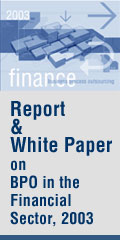|

- Mgt. Courses
- India's Outlook
- BECON-2003
- Micro Finance
- Credit Policy
- Bank Ratings
- Top 15 pages

 Daily News
Daily News
- Banking News
- IT News
- Insurance News
- BPO News
- Market News
 Online Directories
Online Directories
- IT Directory
- BPO Directory
- Bank Directory
- Insurance Cos
 Banking
Banking
- Overview
- Basics
- Products
- Articles
- Policies
- More
 Technology
Technology
- Overview
- Major IT Cos
- Banking Software
- Features
- More
 Finance
Finance
- Overview
- Corporate Finance
- M&A & JV
- Venture Capital
- More
 Insurance
Insurance
- Overview
- Regulators
- Bancassurance
- Products
- More
 BPO
BPO
- Overview
- Opportunities
- News & Trends
- More
 Publications
Publications
- BPO Report
- Doing business
- Outsourcing
- NRI Handbook
- Directory
- More
 More sections
More sections
- Jobs
- Management
- NRIs
- Co-op Banks
- Lifestyle
|
Click Here To Return To Daily News
Click For Other Top Stories
RBI committee headed by G Padmanabhon, has recommended that banks with capital-to-risk-weighted assets ratio (CRAR) of 10 per cent and with minimum networth of Rs 200 crore only be considered for permission to trade in the interest rate futures market. Banks having adequate internal risk management, control systems and robust operational framework could be allowed to run trading positions across various interest rate derivatives including interest rate futures.
To impart greater flexibility, the committee viewed it necessary to introduce products like swap, options on interest rate benchmarks (caps, floors etc). RBI committee has recommended that once the OTC interest rate options like caps and floors are allowed, the same may be permitted to be embedded in the IRS contracts. Vanilla caps and floors on liquid money market benchmarks like Mibid, Mibor, 91-day T-Bill rates should be introduced in the first stage.
Interest rate derivatives such as rate swaps and forward rate agreements were introduced in 1999. At the second stage, the RBI allowed banks and primary dealers (PDs) to transact in exchange-traded interest rate futures in June 2003. While PDs are allowed to trade in these derivatives, banks can use them only to hedge exposures.
According to the RBI, volumes have risen for the interest rate derivatives market in the current fiscal, with data showing that number of contracts rose to 14,748 on October 17 from 9,633 on April 4. The outstanding notional principal amounts also jumped to Rs 3,83,866 crore from Rs 2,42,983 crore in the same period.
|
|
|
|
|
|
|
|
|
|
|
|
|
|
|
|
|
|
|
|
|
|
|
|
|
|
|
|
|
|
|
|
|
|
|
|
|
|
|
|
|
|
|
|
|
|
|
|
|
|
|
|
|
|
|
|
|
|
|
|
| |

-----------

-----------

-----------

-----------

|





